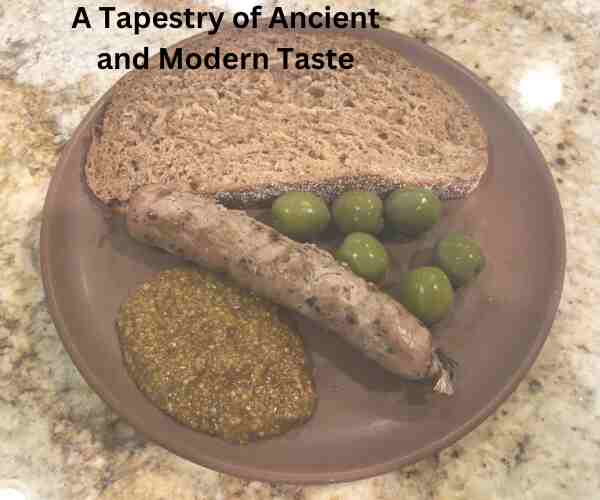Food, an integral aspect of human existence, serves both as a means of survival and a source of pleasure. The Culinary Tapestry: Uniting Humanity Through Food, a Mosaic of Cultural Identities, Religious Traditions, and Festive Celebrations. His exploration delves into the world’s ten oldest dishes, tracing their evolution and enduring presence in contemporary culinary landscapes.
ALSO VISIT: Green Tea Unveiled: A Comprehensive Expedition into the Global Tea Landscape
1.The Ancient Aromas of Indian Curry (circa 2200-2500 B.C.)
Originating from the Tamil word “kari,” curry has become a global term encompassing a spectrum of dishes featuring a sauce or gravy base enriched with proteins and spices, often served over rice. The roots of this delectable dish stretch back approximately 4,000 years to the Indus Valley civilization in Mohenjo-daro, Pakistan. Archaeological excavations revealed traces of essential curry components such as garlic, ginger, and turmeric, marking the oldest known record of these spices. The curry we relish today took shape in the 16th century through interactions with Portuguese and British traders during India’s colonization.
2.Pancakes Dishes: A Timeless Treat (circa 11650 B.C.)
Despite their seemingly modern appeal, pancakes have a culinary history dating back over 70,000 years. Recent discoveries in the Shanidar Cave system in Iraq unveiled evidence of ancient tools and grains used to create an early form of pancakes. Throughout history, societies, including the Greeks, Romans, and Queen Elizabeth’s court, embraced various iterations of pancakes. Today, this ancient delight graces tables in international households and diners, preserving a timeless connection to our culinary past.
3.Linzer Torte: A Slice of Austrian Heritage (circa 1653)
The Linzer torte, hailing from Linz, Austria, stands as one of the world’s oldest cake recipes. Dating back to 1696, this delectable treat comprises a crumbly shortcrust pastry filled with red currant jam, creating a pie-like dessert. Variations, such as raspberry, apricot, or plum fillings, add to its versatility. The Linzer torte, immortalized in its traditional lattice design, has also inspired the creation of Linzer torte cookies, offering a smaller yet equally delightful version enjoyed year-round.
4.Tamales: Ancient Masa Bundles (circa 5000 B.C.)
Tamales, flavorful bundles of meat encased in masa, boast a rich history spanning over 10,000 years. Originally a portable, protein-rich food for soldiers and hunters, tamales evolved through generations, requiring meticulous preparation involving hand-grinding corn and mixing it with lard. Modern adaptations introduce diverse fillings, from savory pork, chicken, or shredded beef with beans and rice to sweet variations featuring cinnamon, butter, and dulce de leche. Tamales endure as a symbol of communal cooking and festive occasions.
5. Burgers: From Isicia Omentata to Fast-Food Phenomenon (circa 100 century A.D.)
While the concept of a hamburger might seem far removed from ancient cuisine, the roots of this beloved dish trace back to the Roman era with the isicia omentata. Comprising minced meats, caul fat, wine, pepper, pine nuts, and garum (a fish sauce), these early patties were cooked over an open flame. The idea of ground meat between slices of bread gained popularity in 19th century America, eventually evolving into the fast-food sensation we know today, with over 91,000 burger restaurants in the United States.
6.Mesopotamian Stew and Bone Broth Dishes: Ancient Potions (circa 2140 B.C. and 400 B.C.)
Deciphered from Sumerian tablets dating back to 2140 B.C., the Babylonian lamb stew stands as the world’s oldest known written recipe. Despite the challenges of interpretation, scholars and chefs have successfully recreated this ancient dish, offering a taste of Mesopotamian culinary heritage. In parallel, Chinese bone soup, discovered in a tomb dating 2,400 years old, represents the earliest recorded instance of bone broth. Today, bone broth enjoys a resurgence in popularity, celebrated for its velvety texture, rich flavor, and health benefits.
7.Rice Pilaf: A Journey Through Time (circa 4530 B.C.)
Rice a staple in many cultures, has a debated history of cultivation, with evidence pointing to India and China as its origins. A delectable dish cooked with broth, spices, and various ingredients, finds its earliest mention in Greece through Archestratus’s cookbook “Gastrology.” The path of pilaf’s dissemination remains contested, connecting to either Persian conquests or an Indian origin. This versatile dish manifests in diverse variations across the Middle East, Europe, and Asia.
8.Beer: From Ancient Pots to Modern Pints (circa 3500 B.C.)
With a retail market exceeding $115 billion in the U.S., beer has evolved from ancient brewing practices to a ubiquitous beverage found in grocery stores and microbreweries. Originating in China and gaining popularity in Mesopotamia around 3500 B.C., beer traveled through trade routes to Egypt and Europe. As technology advanced, beer production flourished, solidifying its status as a beloved global drink.
9. Chocolate Dishes: A Mesoamerican Elixir (circa 1500-400 B.C.)
Cultivated by the Mayans, Aztecs, and Toltecs, the cacao tree gave birth to a ceremonial and medicinal chocolate drink made from cocoa beans. Initially reserved for elite ranks or warriors, chocolate’s journey to Europe began with Christopher Columbus and Hernán Cortés. The 17th century marked its arrival in European courts, and by the 1800s, cocoa powder and chocolate bars emerged, transforming chocolate into the sweet delight we recognize today.
10.Bread: A Culinary Constant (circa 10000–2200 B.C.)
As a dietary staple for over 12,000 years, bread has witnessed a remarkable evolution. Early breads, resembling flatbreads, were crafted with coarsely ground grains and baked on hot rocks. The discovery of a 14,000-year-old piece of bread challenges the conventional narrative, suggesting that baking predates farming. Whether in the form of tortillas, matza, or naan, bread remains an enduring link to our culinary past.
READ MORE
Conclusion
Exploring the world’s oldest dishes unveils a tapestry of flavors, techniques, and cultural exchanges that have transcended millennia. From ancient stews and bone broths to timeless treats like pancakes and chocolate, these culinary treasures continue to influence and inspire contemporary gastronomy. As we savor these dishes today, we participate in a culinary communion with our ancestors, preserving the essence of our shared human history.
